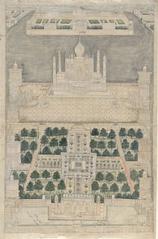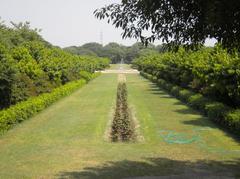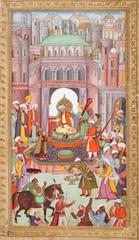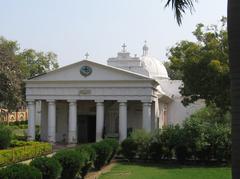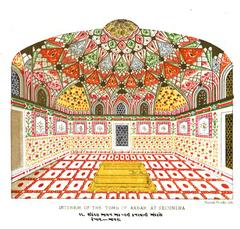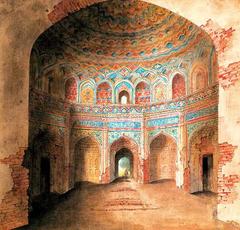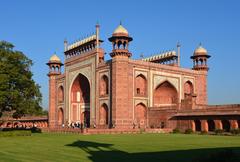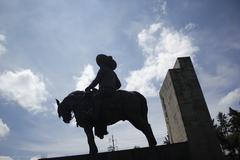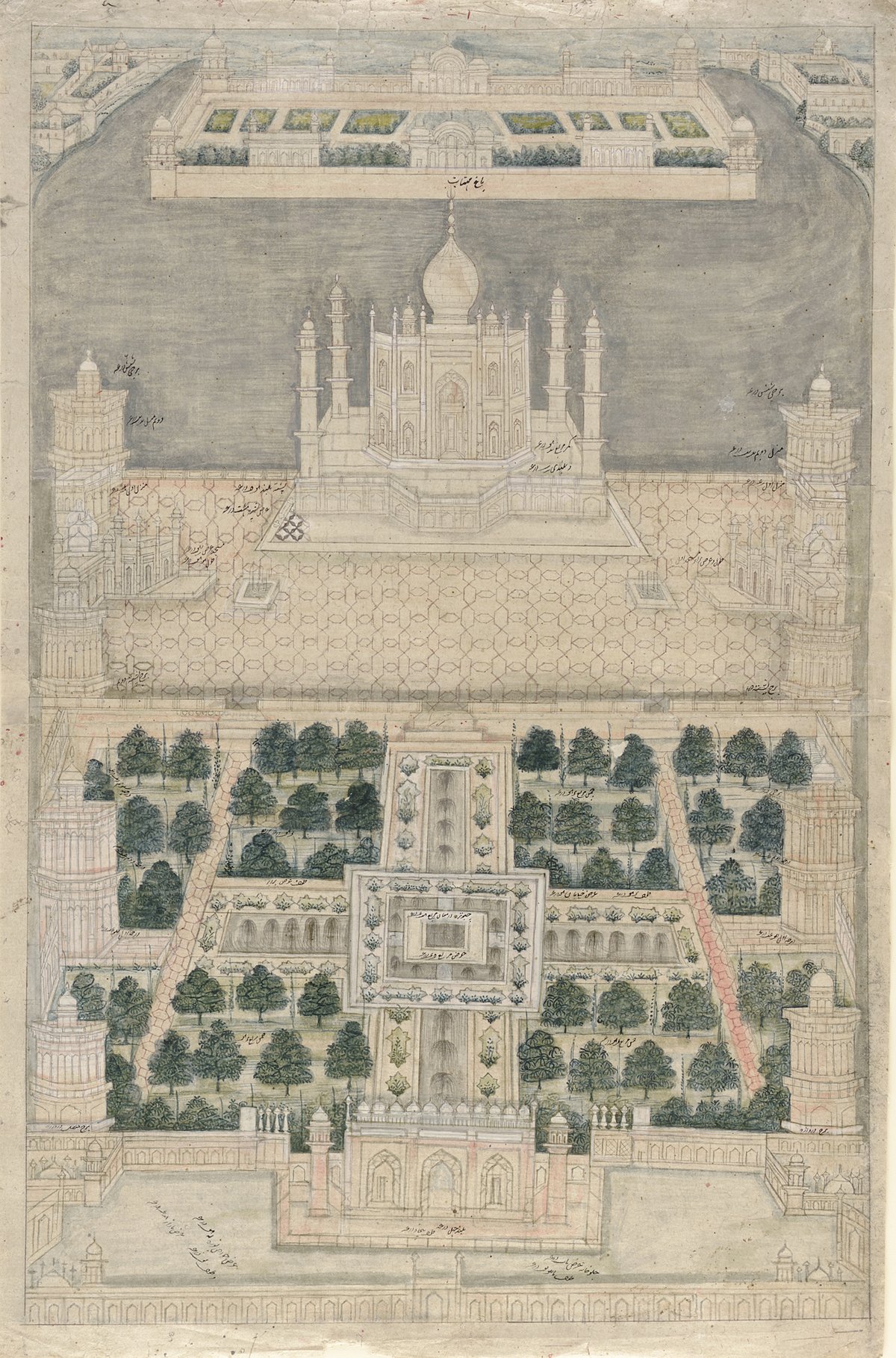
Mehtab Bagh Agra: Visiting Hours, Tickets, History, and Travel Guide
Date: 15/06/2025
Introduction
Mehtab Bagh, known as the “Moonlight Garden,” is a breathtaking Mughal-era garden located on the northern banks of the Yamuna River in Agra, India, directly opposite the Taj Mahal. This serene landscape offers a picturesque vantage point for viewing the Taj Mahal, especially at sunset and on moonlit nights. Originating from Emperor Babur’s vision and later refined under Shah Jahan, Mehtab Bagh exemplifies the grandeur of Mughal landscape architecture and is woven into Agra’s rich cultural and ecological tapestry (Wikipedia; eTicketAgra; Tripoto).
This guide provides a comprehensive overview of Mehtab Bagh’s history, legends, architectural features, visiting hours, ticketing details, accessibility, travel tips, and frequently asked questions, ensuring a rewarding experience for every visitor—whether a history enthusiast, nature lover, or photographer.
Historical Origins and Mughal Significance
Mehtab Bagh was the last in a series of eleven charbagh-style gardens built by the Mughals along the Yamuna riverfront between Agra Fort and the Taj Mahal (Wikipedia). Commissioned by Babur, the founder of the Mughal dynasty, the garden was envisioned as a Persian-style paradise—symmetrical, lush, and tranquil.
Shah Jahan, who built the Taj Mahal, later transformed Mehtab Bagh into a moonlit pleasure garden to enhance the Taj Mahal’s symmetry and beauty. The garden’s original features included plastered walkways, water channels, fountains, airy pavilions, fruit trees, and beds of narcissus, all designed to create a romantic and ethereal ambiance under the moonlight (eTicketAgra).
The Black Taj Mahal Legend
A compelling legend surrounds Mehtab Bagh: the myth of the “Black Taj Mahal.” It is said that Shah Jahan intended to construct a black marble mausoleum for himself opposite the white Taj Mahal, connecting the two by a bridge as an eternal symbol of love (Solitary Traveller; Taj With Guide). However, extensive archaeological excavations have debunked this theory, revealing no evidence of black marble foundations. Instead, findings confirm Mehtab Bagh’s purpose as a Mughal garden, with its precise alignment enhancing the monumentality of the Taj Mahal (ASI Agra Circle).
Archaeological Discoveries and Restoration
Restoration efforts by the Archaeological Survey of India (ASI) in the 1990s revived Mehtab Bagh after centuries of neglect, flooding, and encroachment. Excavations unveiled:
- A large octagonal tank with 25 fountains.
- Remnants of the original charbagh (four-part) layout.
- Brick, lime plaster, sandstone cladding, and domed towers.
- A 289-metre-long river wall and western pathway (TourMyIndia).
The garden was replanted with authentic Mughal-era flora—guava, maulshri, hibiscus, citrus, neem, bauhinia, ashoka, and jamun—following historical records and paleobotanical analysis. This restoration has not only conserved Mughal horticultural traditions but also created a thriving ecological habitat for birds and wildlife.
Architectural and Cultural Highlights
Charbagh Layout and Symmetry
Mehtab Bagh’s layout reflects the classic Mughal charbagh, aligned precisely with the Taj Mahal to maximize visual harmony. The garden’s quadrants are divided by water channels and walkways, with a central octagonal pool mirroring the iconic mausoleum (Tripoto; TourMyIndia).
Water Features and Landscaping
Water played a crucial role in Mughal gardens, symbolizing life and paradise. Mehtab Bagh’s restored fountains and pools cool the landscape and provide stunning reflections of the Taj Mahal, especially under moonlight.
Architectural Elements
- Sandstone Towers: Four octagonal towers at each corner.
- Pavilions: Remnants of Mughal-era shaded seating areas.
- Boundary Walls: Original walls protect the garden from flooding and encroachment (EIndiaTourism).
Cultural Symbolism and Legends
Mehtab Bagh’s design and alignment with the Taj Mahal are rich in symbolism—representing the connection between the earthly and divine, life and death, love and remembrance. The garden’s moonlit ambiance and reflective water features evoke the Islamic concept of paradise and spiritual contemplation (Taj With Guide).
Local folklore adds further intrigue—stories of hidden treasures, secret tunnels, and even curses persist, although none have been substantiated by archaeology (Solitary Traveller).
Visitor Information: Hours, Tickets, and Accessibility
Visiting Hours
- Daily: 6:00 AM to 6:00 PM.
- Night Viewing: Available on full moon nights and two days before/after, 8:30 PM to 12:30 AM (subject to weather and confirmation) (Citybit).
- Note: While Mehtab Bagh is generally open daily (including Fridays), confirm locally for any changes or maintenance closures.
Ticket Prices
- Indian Citizens: ₹15–₹35
- SAARC/BIMSTEC Citizens: ₹15–₹35
- Foreign Nationals: ₹200–₹300
- Children (Below 15): Free
- Night Viewing: ₹510 (Indian), ₹750 (foreigner) (Touryatras; Citybit)
Tickets can be purchased at the entrance or online. Carry cash as card facilities may be limited.
Accessibility and Facilities
- Wheelchair Accessible: Flat, paved pathways suitable for most mobility needs, though some areas may be uneven.
- Restrooms: Basic facilities are available near the entrance.
- Seating and Shade: Benches and shaded areas throughout the garden.
- Shops and Refreshments: Vendors and souvenir shops near the entrance; bring water and snacks during peak hours (TravelWithCG).
Travel Tips and Photography
- Best Time to Visit: October to March; early morning and sunset for ideal lighting and fewer crowds (GuideTour; Taj Mahal Travel).
- Combining Itinerary: Pair your visit with the Taj Mahal, Agra Fort, and Itimad-ud-Daulah’s Tomb for a comprehensive Agra experience.
- Guided Tours: Hiring a local guide can provide deeper insight into the garden’s history and legends (Sunshine Seeker).
- Photography: The central fountain area offers the best views of the Taj Mahal. Tripods are usually allowed, but verify with security.
- Wildlife: Look out for peacocks, parrots, squirrels, and monkeys—avoid feeding animals (Citybit).
- Dress and Conduct: Wear comfortable, modest clothing; respect the heritage site by not littering or damaging flora (Ease India Trip).
Frequently Asked Questions (FAQ)
Q: What are Mehtab Bagh’s visiting hours?
A: 6:00 AM to 6:00 PM daily; night viewing on full moon nights (advance confirmation advised).
Q: How much do tickets cost?
A: ₹15–₹35 (Indians/SAARC/BIMSTEC), ₹200–₹300 (foreigners), free for children under 15.
Q: Is Mehtab Bagh wheelchair accessible?
A: Yes, with mostly flat, paved pathways and accessible restrooms.
Q: Can I use a tripod for photography?
A: Generally allowed; check with security for any restrictions.
Q: Are guided tours available?
A: Yes, local guides offer informative tours.
Q: When is the best time to visit?
A: October to March, at sunrise or sunset for the best views and cooler temperatures.
Nearby Attractions
- Taj Mahal: 3 km across the Yamuna.
- Agra Fort: 8 km away.
- Itimad-ud-Daulah’s Tomb: Nearby and worth a visit.
- Ram Bagh: Another historic Mughal garden.
Summary
Mehtab Bagh stands as a living testament to the grandeur of Mughal garden design, architectural ingenuity, and Agra’s deep-rooted history. Its restored charbagh layout, lush flora, and tranquil ambiance provide not only a magnificent vantage point for the Taj Mahal but also a profound connection to India’s cultural heritage. While legends like the “Black Taj Mahal” lend an air of mystery, archaeological evidence firmly places Mehtab Bagh as a moonlit pleasure garden—a paradise envisioned by emperors and cherished by generations (Wikipedia; ASI Agra Circle).
By planning your visit with the information provided here, you can ensure a memorable and enriching experience at one of Agra’s must-see historical sites. To stay updated, download the Audiala app, follow our social channels, and explore related articles for more insights into Agra’s rich heritage (eTicketAgra; TourMyIndia; Touryatras; Taj With Guide; Tripoto).
Reliable Sources and Further Reading
- Mehtab Bagh – Wikipedia
- Mehtab Bagh: Visiting Hours, Tickets, and History – eTicketAgra
- Discover Mehtab Bagh in Agra – Tripoto
- Visiting Hours and Significance – TourMyIndia
- Complete Guide – Touryatras
- Legends of Mehtab Bagh – Taj With Guide
- ASI Agra Circle: Excavations and Features
